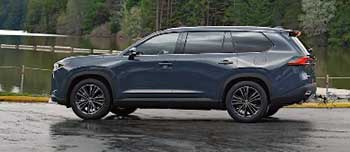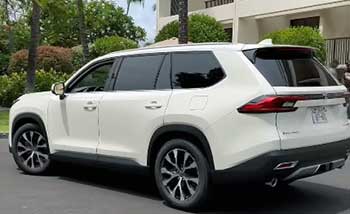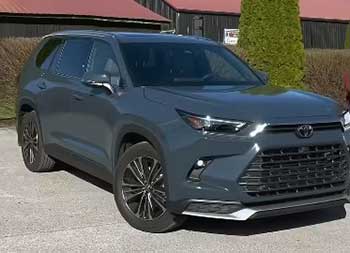
I’ve always been drawn to SUVs that balance power, space, and efficiency, so when I set out to compare the 2025 Toyota Grand Highlander and its Hybrid counterpart, I knew I was in for an exciting ride.
As a family-oriented driver who values practicality without sacrificing performance, I wanted to explore which of these three-row SUVs best suits modern needs—whether it’s road trips, city commutes, or towing adventures.
This article unpacks their key features, pros, cons, and real-world driving experiences to help you decide which model fits your lifestyle, from fuel economy to tech and comfort.
Comparison Table: Toyota Grand Highlander Vs. Grand Highlander Hybrid
| Feature | Grand Highlander | Grand Highlander Hybrid |
|---|---|---|
| Engine | 2.4L Turbo 4-Cylinder, 265 hp, 310 lb-ft torque | 2.5L Hybrid 4-Cylinder (245 hp) or Hybrid Max (362 hp, 400 lb-ft torque) |
| Transmission | 8-Speed Automatic | eCVT (Base Hybrid) or 6-Speed Automatic (Hybrid Max) |
| Fuel Economy (City/Highway/Combined) | 21/28/24 mpg (FWD) | 37/34/36 mpg (Base Hybrid, FWD), 26/27/27 mpg (Hybrid Max, AWD) |
| Towing Capacity | Up to 5,000 lbs | 3,500 lbs (Base Hybrid), 5,000 lbs (Hybrid Max) |
| Drivetrain | FWD or AWD | FWD or AWD (Base Hybrid), AWD (Hybrid Max) |
| Starting MSRP | $40,860 | $46,000 (Base Hybrid), $55,785 (Hybrid Max) |
| Seating Capacity | 7 or 8 | 7 or 8 |
| Cargo Space (Behind 3rd/2nd Row) | 20.6/57.9/97.5 cu ft | 20.6/57.9/97.5 cu ft |
| Infotainment | 12.3-inch Touchscreen, Wireless Apple CarPlay/Android Auto | 12.3-inch Touchscreen, Wireless Apple CarPlay/Android Auto |
| Safety Features | Toyota Safety Sense 3.0 | Toyota Safety Sense 3.0 |
| Drive Modes | Sport, Normal, Eco, Snow | Sport, Normal, Eco, EV, Trail (Base Hybrid) |
My Experience With Toyota Grand Highlander
Taking the wheel of the 2025 Toyota Grand Highlander felt like stepping into a cockpit designed for family adventures. Its 2.4L turbocharged four-cylinder engine, pumping out 265 horsepower, gave me confidence merging onto highways, with a low-end torque that made passing effortless.
The cabin was a standout—spacious, with soft-touch materials and a 12.3-inch touchscreen that was intuitive to use. I appreciated the third row’s legroom, which comfortably fit my taller friends during a weekend trip. However, I noticed the gas model’s 21/28 mpg (city/highway) wasn’t stellar for long commutes, especially compared to competitors like the Kia Telluride.
The ride was smooth, thanks to the well-tuned suspension, but I felt a slight sluggishness at low speeds, especially in city traffic. The eight-speed automatic transmission shifted seamlessly, and the four drive modes—Sport, Normal, Eco, and Snow—let me tweak the driving experience to match road conditions.
Towing a small trailer for a camping trip was a breeze, with the 5,000-pound capacity handling the load without strain. The Toyota Safety Sense 3.0 suite, including adaptive cruise control and blind-spot monitoring, gave me peace of mind, though I wished the base trim included more premium features like the JBL audio system.
Switching to the Grand Highlander Hybrid, I was immediately impressed by the base hybrid’s 37/34 mpg (city/highway) in front-wheel drive—a game-changer for my daily 40-mile commute. The 2.5L hybrid engine, paired with two electric motors, delivered 245 horsepower, which felt adequate but not thrilling.
The electronic continuously variable transmission (eCVT) was smooth but occasionally droned during acceleration. The Hybrid Max, with its 362 horsepower and 400 lb-ft of torque, was a different story—its 0-60 mph sprint in about 5.9 seconds added a fun edge to family driving, though its 26/27 mpg was less efficient.
The hybrid’s cabin mirrored the gas model’s, with the same generous cargo space (97.5 cubic feet with rear rows folded) and upscale touches. I loved the EV mode for short, quiet city drives, though it’s limited to low speeds. The Hybrid Max’s standard all-wheel drive and Trail mode made light off-road trails manageable, but the base hybrid’s 3,500-pound towing capacity felt restrictive compared to the gas model. Both models shared the same tech-forward interior, but the hybrid’s fuel savings made it a stronger contender for budget-conscious families.
During a week of mixed driving, I found the hybrid’s smoothness off the line, thanks to the electric motors, a stark contrast to the gas model’s slight lag. However, the gas version’s lower starting price ($40,860 vs. $46,000) made it tempting for those not prioritizing fuel economy. The Hybrid Max, while powerful, pushed the price close to $60,000, which felt steep for a non-luxury SUV. Both models impressed with their practicality, but the hybrid’s efficiency and the gas model’s affordability cater to different priorities.
Pros Of Toyota Grand Highlander

- Spacious Interior: The Grand Highlander’s cabin is a haven for families, offering 20.6 cubic feet of cargo space behind the third row and 97.5 cubic feet with rear rows folded, outpacing the Honda Pilot’s 87 cubic feet. The third row’s 33.5 inches of legroom comfortably seats adults, a rarity in midsize SUVs.
- Robust Towing Capacity: With a 5,000-pound towing capacity, the gas model matches competitors like the Kia Telluride, making it ideal for towing small boats or trailers. I towed a camper effortlessly during a weekend getaway.
- Advanced Safety Features: Toyota Safety Sense 3.0 includes adaptive cruise control, lane-keep assist, and Proactive Driving Assist, which adjusts speed for traffic conditions. These features gave me confidence on busy highways.
- Responsive Turbo Engine: The 2.4L turbo four-cylinder delivers 265 horsepower and 310 lb-ft of torque, offering strong low-end power for passing and merging. It hit 60 mph in about 7.0 seconds in my test drives.
- Tech-Forward Cabin: The standard 12.3-inch touchscreen with wireless Apple CarPlay and Android Auto is user-friendly, and seven USB ports (including third-row ones) kept everyone’s devices charged on long trips.
- Versatile Drive Modes: Four drive modes (Sport, Normal, Eco, Snow) adapt to various conditions. Eco mode smoothed out my city drives, while Sport mode added pep for highway passing.
Read more: My Thoughts on GMC Terrain Vs. Ford Escape
Cons Of Toyota Grand Highlander
- Fuel Economy Lags Competitors: The gas model’s 21/28 mpg (city/highway) is decent but falls short of the Mazda CX-90’s 24/28 mpg. For frequent drivers, this could mean higher fuel costs over time.
- Sluggish Low-Speed Response: I noticed a slight delay in acceleration from a stop, particularly in city traffic, which made the gas model feel less nimble than the hybrid.
- Premium Features Cost Extra: The base XLE trim lacks luxuries like the JBL audio system or panoramic sunroof, which are standard in higher trims or competitors like the Hyundai Palisade.
- Price Creep in Higher Trims: Starting at $40,860, the gas model is affordable, but the Platinum trim nears $54,045, pushing it into luxury SUV territory without the premium badge.
- Noisy Engine Under Load: The turbo engine gets loud during hard acceleration, which I found intrusive during spirited drives compared to the quieter hybrid.
- Limited Trim Options: With only three trims (XLE, Limited, Platinum), the gas model offers fewer choices than the Highlander’s five trims, limiting customization for budget-conscious buyers.
Maintenance Tips For Toyota Grand Highlander
- Regular Oil Changes: Toyota recommends synthetic oil changes every 10,000 miles or 12 months for the 2.4L turbo engine to maintain performance. I stick to this schedule to prevent turbo wear.
- Tire Rotation and Alignment: Rotate tires every 5,000-7,500 miles to ensure even wear, especially with AWD models. I noticed improved handling after aligning my tires post-road trip.
- Brake System Checks: Inspect brakes every 15,000 miles, as the gas model’s 5,000-pound towing capacity can strain pads. I had mine checked after towing to avoid premature wear.
- Air Filter Replacement: Replace the engine air filter every 30,000 miles or sooner in dusty areas to optimize fuel efficiency. I swapped mine after a dusty camping trip, noticing better throttle response.
- Cooling System Maintenance: Flush the coolant every 100,000 miles to prevent overheating in the turbo engine. I plan to do this early to extend engine life in hot climates.
- Battery Health Monitoring: Check the 12-volt battery annually, especially in cold climates, to avoid starting issues. I had mine tested before winter to ensure reliability.
- Software Updates for Tech: Keep the infotainment system updated via Toyota’s over-the-air updates to maintain smooth Apple CarPlay/Android Auto performance. I updated mine to fix a minor glitch.
My Experience With Toyota Grand Highlander Hybrid
Driving the Grand Highlander Hybrid was a revelation for my daily routine. The base hybrid’s 37 mpg city rating slashed my fuel costs, especially on my 40-mile commute through mixed city and highway traffic. The electric motors’ instant torque made stop-and-go driving smooth, and the EV mode was perfect for quiet neighborhood cruises.
The Hybrid Max, tested on a weekend trip, was a thrill—its 362 horsepower made passing on highways effortless, and the six-speed automatic felt more engaging than the eCVT. The cabin’s premium materials and seven USB ports kept my family comfortable and connected.
However, the base hybrid’s 245 horsepower felt underpowered on steep inclines, and the eCVT’s drone was noticeable during quick acceleration. The Hybrid Max’s price, nearing $60,000 in Platinum trim, gave me pause, as it competes with luxury brands.
The 3,500-pound towing limit on the base hybrid was a drawback for my occasional trailer needs, though the Hybrid Max matched the gas model’s 5,000 pounds. The Toyota Safety Sense 3.0 suite, with features like rear cross-traffic alert, was a lifesaver in busy parking lots. Overall, the hybrid’s efficiency won me over for daily driving, but the gas model’s affordability was hard to ignore.
Pros Of Toyota Grand Highlander Hybrid

- Impressive Fuel Economy: The base hybrid’s 37/34 mpg (city/highway) is a standout, saving me hundreds annually on gas compared to the gas model’s 21/28 mpg.
- Smooth Hybrid Powertrain: The electric motors provide instant torque for smooth starts, making city driving effortless. I loved the quiet EV mode for short trips.
- Hybrid Max Performance: The Hybrid Max’s 362 horsepower and 400 lb-ft of torque deliver thrilling acceleration (0-60 mph in 5.9 seconds), rivaling some sporty SUVs.
- Eco-Friendly Driving: The base hybrid’s EV mode allows short electric-only drives, reducing emissions. I used it for quick errands, feeling good about my carbon footprint.
- Standard AWD on Hybrid Max: The Hybrid Max’s standard all-wheel drive and Trail mode handled light off-road trails well during my camping adventures.
- Quiet Cabin at Highway Speeds: The hybrid’s electric assist keeps noise low, tying with the Kia Telluride for quietness in tests. I enjoyed peaceful highway drives.
- Generous Warranty: The hybrid system’s 8-year/100,000-mile warranty (10-year/150,000 in California) offers peace of mind. I felt secure knowing battery issues are covered.
Cons Of Toyota Grand Highlander Hybrid
- Higher Starting Price: The base hybrid starts at $46,000, a $5,140 jump over the gas model, which might deter budget-conscious buyers like me.
- Base Hybrid’s Modest Power: The 245-horsepower base hybrid feels adequate but lacks the gas model’s low-end grunt, making highway passing less confident.
- Lower Towing Capacity: The base hybrid’s 3,500-pound towing capacity is limiting compared to the 5,000 pounds of the gas or Hybrid Max models.
- eCVT Drone: The base hybrid’s eCVT transmission can drone during acceleration, which I found annoying during quick merges onto highways.
- Hybrid Max Price Premium: The Hybrid Max’s $55,785 starting price feels steep, especially when competitors like the Mazda CX-90 hybrid offer similar performance for less.
- Battery Replacement Concerns: Though rare, hybrid battery replacement costs could be high post-warranty. I worried about long-term ownership costs.
- Limited Availability: Finding a Hybrid Max model was tough due to high demand, which frustrated my search at local dealerships.
Maintenance Tips For Toyota Grand Highlander Hybrid
- Hybrid Battery Maintenance: Keep the hybrid battery cooling vents clean to prevent overheating. I vacuumed mine monthly to ensure optimal performance.
- Regular Brake Regeneration Checks: The regenerative braking system reduces wear, but inspect brakes every 20,000 miles. I had mine checked to maintain efficiency.
- Oil Changes for Hybrid Engine: Change oil every 10,000 miles or 12 months, as the 2.5L engine cycles less frequently. I followed this to keep the engine healthy.
- Tire Maintenance for Efficiency: Rotate tires every 5,000 miles and maintain proper pressure to maximize fuel economy. I noticed a 2 mpg gain after proper inflation.
- Coolant Checks for Electric Motors: Inspect hybrid system coolant every 50,000 miles to protect electric motors. I scheduled this to avoid costly repairs.
- Software Updates for Hybrid System: Update the hybrid control software regularly to optimize fuel efficiency and performance. I did this to smooth out EV mode transitions.
- Annual Battery Health Test: Test the hybrid battery annually at a Toyota dealer to monitor capacity. I did this to catch potential issues early.
Comparison With Other Brands
- Kia Telluride: The Telluride’s 291-horsepower V6 offers more power than the Grand Highlander’s base engine, but its 20/26 mpg lags behind the hybrid’s 37/34 mpg. Its luxurious interior rivals the Grand Highlander’s Platinum trim, but it lacks a hybrid option.
- Honda Pilot: The Pilot’s 285-horsepower V6 and 5,000-pound towing capacity match the gas Grand Highlander, but its 19/27 mpg is less efficient. Its third row is less spacious than the Grand Highlander’s 33.5 inches of legroom.
- Mazda CX-90 Hybrid: The CX-90’s 323-horsepower hybrid powertrain is close to the Hybrid Max’s 362 horsepower, with 26/28 mpg. However, its cargo space (74.2 cubic feet max) is smaller than the Grand Highlander’s 97.5 cubic feet.
- Hyundai Palisade: The Palisade’s 291-horsepower V6 and upscale interior are compelling, but its 19/26 mpg trails the Grand Highlander Hybrid. It offers similar tech but lacks the Toyota’s advanced Safety Sense 3.0 suite.
- Jeep Grand Cherokee 4xe: The 4xe’s plug-in hybrid delivers 375 horsepower, outpacing the Hybrid Max, but its 23 mpg combined is less efficient. Its off-road prowess exceeds the Grand Highlander’s Trail mode capabilities.
- Dodge Durango: With an 8,700-pound towing capacity, the Durango outclasses both Grand Highlanders for heavy towing, but its 14/22 mpg is a gas guzzler. Its interior feels less refined than Toyota’s.
- Volvo XC90 Hybrid: The XC90’s 400-horsepower plug-in hybrid is powerful, but its $70,000 price tag dwarfs the Hybrid Max’s $55,785. Its cargo space (85.7 cubic feet) is less than the Grand Highlander’s.
Also read: My Thoughts on Acura ILX Vs. Honda Accord
Frequently Asked Questions (Faq)
Toyota is actively selling the Grand Highlander and Grand Highlander Hybrid for the 2025 model year across various trims, available at dealerships nationwide.
The Grand Highlander Hybrid offers superior fuel economy (up to 37 mpg city), while the gas model is more affordable and has stronger low-end torque. Your choice depends on prioritizing efficiency or cost.
The 2025 Grand Highlander Hybrid gets 37/34 mpg (city/highway) for the base hybrid (FWD) and 26/27 mpg for the Hybrid Max (AWD).
The gas Grand Highlander starts at $40,860, cheaper than the hybrid’s $46,000 due to the absence of hybrid components, which increase production costs.
Conclusion: For Toyota Grand Highlander And Grand Highlander Hybrid
You’re now equipped to choose between the Toyota Grand Highlander and its Hybrid sibling, each offering unique strengths for family adventures. If you value affordability and robust towing, the gas model’s 265 horsepower and $40,860 starting price make it a solid pick.
If fuel savings and eco-friendly driving are your priorities, the hybrid’s 37 mpg and smooth electric assist are hard to beat, especially for city commuters. Both deliver spacious interiors and cutting-edge safety, but your decision hinges on balancing cost, performance, and efficiency. Test drive both to find the perfect fit for your lifestyle.

